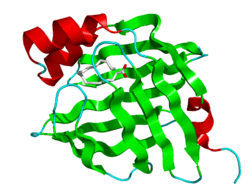adipocyte protein 2
aP2 (adipocyte Protein 2)[5] is a carrier protein for fatty acids that is primarily expressed in adipocytes and macrophages. aP2 is also called fatty acid binding protein 4 (FABP4). Blocking this protein either through genetic engineering or drugs[6][7] has the possibility of treating heart disease,[8] diabetes,[9] asthma,[10] obesity,[11][12] fatty liver disease[13] and cancer[12][14].
See also
References
- GRCh38: Ensembl release 89: ENSG00000170323 - Ensembl, May 2017
- GRCm38: Ensembl release 89: ENSMUSG00000062515 - Ensembl, May 2017
- "Human PubMed Reference:". National Center for Biotechnology Information, U.S. National Library of Medicine.
- "Mouse PubMed Reference:". National Center for Biotechnology Information, U.S. National Library of Medicine.
- Baxa CA, Sha RS, Buelt MK, Smith AJ, Matarese V, Chinander LL, Boundy KL, Bernlohr DA (1989). "Human adipocyte lipid-binding protein: purification of the protein and cloning of its complementary DNA". Biochemistry. 28 (22): 8683–90. doi:10.1021/bi00448a003. PMID 2481498.
- Forbes health article July 14, 2006
- Medicinenet.com
- Makowski L, Boord JB, Maeda K, Babaev VR, Uysal KT, Morgan MA, Parker RA, Suttles J, Fazio S, Hotamisligil GS, Linton MF (2001). "Lack of macrophage fatty-acid-binding protein aP2 protects mice deficient in apolipoprotein E against atherosclerosis". Nat. Med. 7 (6): 699–705. doi:10.1038/89076. PMC 4027052. PMID 11385507.
- Furuhashi M, Tuncman G, Görgün CZ, Makowski L, Atsumi G, Vaillancourt E, Kono K, Babaev VR, Fazio S, Linton MF, Sulsky R, Robl JA, Parker RA, Hotamisligil GS (2007). "Treatment of diabetes and atherosclerosis by inhibiting fatty-acid-binding protein aP2". Nature. 447 (7147): 959–65. doi:10.1038/nature05844. PMC 4076119. PMID 17554340.
- Shum BO, Mackay CR, Gorgun CZ, Frost MJ, Kumar RK, Hotamisligil GS, Rolph MS (2006). "The adipocyte fatty acid-binding protein aP2 is required in allergic airway inflammation". J. Clin. Invest. 116 (8): 2183–2192. doi:10.1172/JCI24767. PMC 1501108. PMID 16841093.
- Maeda K, Cao H, Kono K, Gorgun CZ, Furuhashi M, Uysal KT, Cao Q, Atsumi G, Malone H, Krishnan B, Minokoshi Y, Kahn BB, Parker RA, Hotamisligil GS (2005). "Adipocyte/macrophage fatty acid binding proteins control integrated metabolic responses in obesity and diabetes". Cell Metab. 1 (2): 107–19. doi:10.1016/j.cmet.2004.12.008. PMID 16054052.
- Hao J, Zhang Y, Yan X, Yan F, Sun Y, Zeng J, Waigel S, Yin Y, Fraig MM, Egilmez NK, Suttles J, Kong M, Liu S, Cleary MP, Sauter E, Li B (2018). "Circulating adipose fatty acid binding protein is a new link underlying obesity-associated breast/mammary tumor development". Cell Metab. 28 (5): 689–705. doi:10.1016/j.cmet.2018.07.006. PMC 6221972. PMID 30100196.
- Makowski L, Hotamisligil GS (2005). "The role of fatty acid binding proteins in metabolic syndrome and atherosclerosis". Curr. Opin. Lipidol. 16 (5): 543–8. doi:10.1097/01.mol.0000180166.08196.07. PMC 3904771. PMID 16148539.
- Hao J, Yan F, Zhang Y, Triplett A, Zhang Y, Schultz DA, Sun Y, Zeng J, Silverstein K, Zheng Q, Bernlohr DA, Cleary MP, Egilmez NK, Sauter E, Liu S, Suttles J, Li B (2018). "Expression of adipocyte/macrophage fatty acid-binding protein in tumor-associated macrophages promotes breast cancer progression" (PDF). Cancer Research. 78 (9): 2343–2355. doi:10.1016/j.cmet.2018.07.006. PMC 5932212. PMID 29437708.
External links
- FABP4+protein,+human at the US National Library of Medicine Medical Subject Headings (MeSH)
- Human FABP4 genome location and FABP4 gene details page in the UCSC Genome Browser.
- PDBe-KB provides an overview of all the structure information available in the PDB for Human Fatty acid-binding protein, adipocyte
- PDBe-KB provides an overview of all the structure information available in the PDB for Mouse Fatty acid-binding protein, adipocyte
This article is issued from Wikipedia. The text is licensed under Creative Commons - Attribution - Sharealike. Additional terms may apply for the media files.




